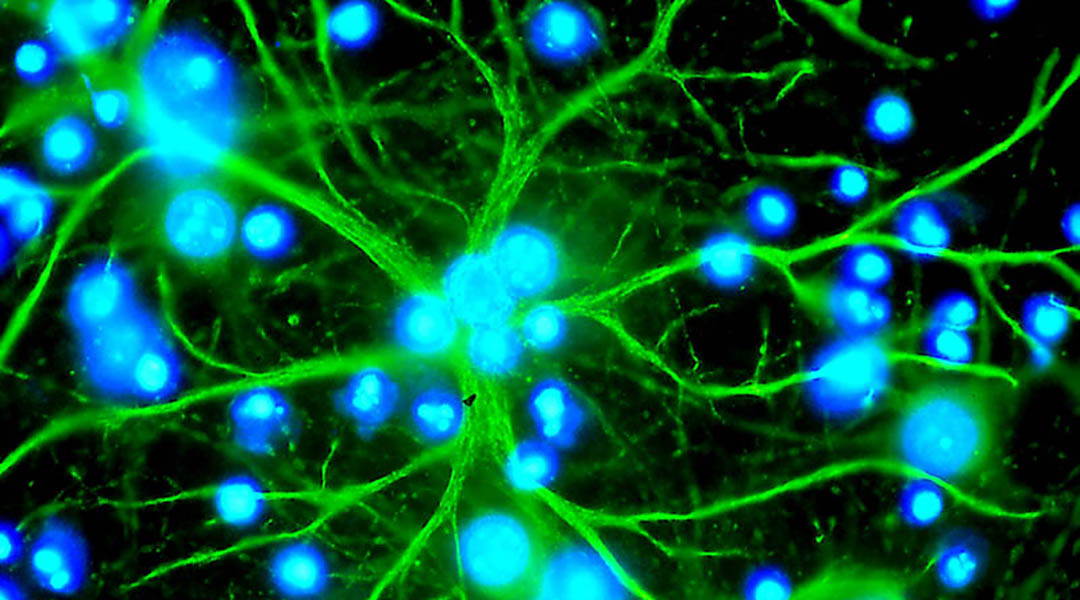The rhythmic movement of a specialized group of brain cells called astrocytes may be an entirely new way neural cell networks transmit information. Astrocytes are not neurons themselves, but they are one of the most numerous types of cells in the brain.
These star-shaped cells do not have synapses, they do not conduct electrical currents, or send and receive chemical signals called neurotransmitters, but evidence has emerged that they do modulate neuron function.
How they do it is a mystery, but a team of researchers believe the answer may lie in decoding the rhythmic stiffening and relaxing of the astrocyte cell surface.
Exciting the cells skeleton
Spanning the inner surface of cells is a network of filaments that determine cellular shape and their ability to move via physical or mechanical changes to the cell surface. These filaments are made of a protein called actin and together are called the actin cytoskeleton.
“When you have a chemical signal, a chemoattractant, the actin scaffolding gels, it forms a branch network that pushes parts of the boundary out, and the cell starts moving,” explained Wolfgang Losert, a biophysicist at the University of Maryland and co-author of a new paper in Advanced Biology investigating the actin cytoskeletons of astrocytes.
In the last decade, researchers have found that the actin cytoskeleton is also active in the absence of stimulus. There is a rhythmic pattern of stiffening and relaxing that moves like oscillations or waves across the cell surface.
This property makes the actin cytoskeleton an excitable system just like the brain’s network of neurons throughout which electrical impulses fire both in response to stimulus but also rhythmically on their own when no stimulus is present. This also hints at the actin cytoskeleton being capable of transmitting information in a similar way, albeit in a completely new language.
Given these new insights, Losert immediately wanted to know if astrocyte cytoskeletons behaved the same way because astrocytes have a unique position in the brain acting as a bridge between blood vessels and neurons. Wedged between these two systems, astrocytes are ideal candidates to sense physiological signals and pass information to neurons.
Seeing this unique position and the emerging evidence that astrocytes are in fact modulating neurons led Losert and co-author Valentina Benfenati, a neuroscience researcher with the National Research Council of Italy, to hypothesize that actin cytoskeletons may be a route for this communication.
Pushing and pulling on neurons
To understand how astrocytes might be in communication with neural networks, the researchers needed to show that astrocyte actin cytoskeletons displayed the properties of an excitable network. Specifically, the rhythmic stiffening and relaxing of the cytoskeleton, and the response of this rhythm to stimulus.
Using rodent astrocytes in a series of in vitro studies, the team found that astrocyte cytoskeletons were in indeed behaving this way.
“When we look at the boundary of a cell, we see not exactly with a very well-defined rhythm, but we see periodically, activity appear and disappear,” said Losert. Amazingly, the periodic activity got stronger and tended to occur hot spots on the surface if the astrocytes were growing on a network of neurons and in response to physiological conditions such as ion concentrations in the cell’s surroundings and even the texture of the surface the cells were grown on.
“So suddenly, we have to think about astrocytes as not just holding on to neurons and blood vessels but also maybe periodically pushing and pushing more often under certain conditions,” said Losert. “How that impacts neuronal communication, we don’t know.”
A new language
These results lead to more questions but importantly reveal that astrocytes are not simply strengthening or weaking synaptic connections overtime, which is the traditional view. Instead, they may be rhythmically modulating them in response to the environment.
If true, Losert and Benfenati have uncovered a potentially new language the brain uses to transmit information. One that doesn’t function on the scale of ions and electrical impulses but on a larger and slower scale through the physical movement of the cytoskeleton.
This opens an entirely new way of studying brain function and importantly, brain disease too. How the rhythms of astrocytes are altered by disease or injury is avenue Benfenati is keen to follow up on.
For Benfenati, the allure of studying the brain comes down to one question: how does this organ compute so much information?
“So far, this has been explained with a binary idea like on and off, all or nothing, and that’s neurons, she said. “We are trying slowly to introduce the concept that there might be other variables, as excitable systems that are correlated to different spatial scales, temperature scales, but even languages, that could be important for the brain.”
Reference: Kate M. O’Neill, et al., Decoding Natural Astrocyte Rhythms: Dynamic Actin Waves Result from Environmental Sensing by Primary Rodent Astrocytes, Advanced Biology (2023), DOI: 10.1002/adbi.202200269
Feature image credit: Karin Pierre, Institut de Physiologie, UNIL, Lausanne/Alliance Européenne Dana pour le Cerveau (EDAB)

















